Yingyu Li
Robust Federated Learning against Model Perturbation in Edge Networks
May 30, 2025Abstract:Federated Learning (FL) is a promising paradigm for realizing edge intelligence, allowing collaborative learning among distributed edge devices by sharing models instead of raw data. However, the shared models are often assumed to be ideal, which would be inevitably violated in practice due to various perturbations, leading to significant performance degradation. To overcome this challenge, we propose a novel method, termed Sharpness-Aware Minimization-based Robust Federated Learning (SMRFL), which aims to improve model robustness against perturbations by exploring the geometrical property of the model landscape. Specifically, SMRFL solves a min-max optimization problem that promotes model convergence towards a flat minimum by minimizing the maximum loss within a neighborhood of the model parameters. In this way, model sensitivity to perturbations is reduced, and robustness is enhanced since models in the neighborhood of the flat minimum also enjoy low loss values. The theoretical result proves that SMRFL can converge at the same rate as FL without perturbations. Extensive experimental results show that SMRFL significantly enhances robustness against perturbations compared to three baseline methods on two real-world datasets under three perturbation scenarios.
Physical-Layer Semantic-Aware Network for Zero-Shot Wireless Sensing
Dec 08, 2023Abstract:Device-free wireless sensing has recently attracted significant interest due to its potential to support a wide range of immersive human-machine interactive applications. However, data heterogeneity in wireless signals and data privacy regulation of distributed sensing have been considered as the major challenges that hinder the wide applications of wireless sensing in large area networking systems. Motivated by the observation that signals recorded by wireless receivers are closely related to a set of physical-layer semantic features, in this paper we propose a novel zero-shot wireless sensing solution that allows models constructed in one or a limited number of locations to be directly transferred to other locations without any labeled data. We develop a novel physical-layer semantic-aware network (pSAN) framework to characterize the correlation between physical-layer semantic features and the sensing data distributions across different receivers. We then propose a pSAN-based zero-shot learning solution in which each receiver can obtain a location-specific gesture recognition model by directly aggregating the already constructed models of other receivers. We theoretically prove that models obtained by our proposed solution can approach the optimal model without requiring any local model training. Experimental results once again verify that the accuracy of models derived by our proposed solution matches that of the models trained by the real labeled data based on supervised learning approach.
Reasoning over the Air: A Reasoning-based Implicit Semantic-Aware Communication Framework
Jun 20, 2023



Abstract:Semantic-aware communication is a novel paradigm that draws inspiration from human communication focusing on the delivery of the meaning of messages. It has attracted significant interest recently due to its potential to improve the efficiency and reliability of communication and enhance users' QoE. Most existing works focus on transmitting and delivering the explicit semantic meaning that can be directly identified from the source signal. This paper investigates the implicit semantic-aware communication in which the hidden information that cannot be directly observed from the source signal must be recognized and interpreted by the intended users. To this end, a novel implicit semantic-aware communication (iSAC) architecture is proposed for representing, communicating, and interpreting the implicit semantic meaning between source and destination users. A projection-based semantic encoder is proposed to convert the high-dimensional graphical representation of explicit semantics into a low-dimensional semantic constellation space for efficient physical channel transmission. To enable the destination user to learn and imitate the implicit semantic reasoning process of source user, a generative adversarial imitation learning-based solution, called G-RML, is proposed. Different from existing communication solutions, the source user in G-RML does not focus only on sending as much of the useful messages as possible; but, instead, it tries to guide the destination user to learn a reasoning mechanism to map any observed explicit semantics to the corresponding implicit semantics that are most relevant to the semantic meaning. Compared to the existing solutions, our proposed G-RML requires much less communication and computational resources and scales well to the scenarios involving the communication of rich semantic meanings consisting of a large number of concepts and relations.
Distributed Traffic Synthesis and Classification in Edge Networks: A Federated Self-supervised Learning Approach
Feb 01, 2023Abstract:With the rising demand for wireless services and increased awareness of the need for data protection, existing network traffic analysis and management architectures are facing unprecedented challenges in classifying and synthesizing the increasingly diverse services and applications. This paper proposes FS-GAN, a federated self-supervised learning framework to support automatic traffic analysis and synthesis over a large number of heterogeneous datasets. FS-GAN is composed of multiple distributed Generative Adversarial Networks (GANs), with a set of generators, each being designed to generate synthesized data samples following the distribution of an individual service traffic, and each discriminator being trained to differentiate the synthesized data samples and the real data samples of a local dataset. A federated learning-based framework is adopted to coordinate local model training processes of different GANs across different datasets. FS-GAN can classify data of unknown types of service and create synthetic samples that capture the traffic distribution of the unknown types. We prove that FS-GAN can minimize the Jensen-Shannon Divergence (JSD) between the distribution of real data across all the datasets and that of the synthesized data samples. FS-GAN also maximizes the JSD among the distributions of data samples created by different generators, resulting in each generator producing synthetic data samples that follow the same distribution as one particular service type. Extensive simulation results show that the classification accuracy of FS-GAN achieves over 20% improvement in average compared to the state-of-the-art clustering-based traffic analysis algorithms. FS-GAN also has the capability to synthesize highly complex mixtures of traffic types without requiring any human-labeled data samples.
Adversarial Learning for Implicit Semantic-Aware Communications
Jan 27, 2023Abstract:Semantic communication is a novel communication paradigm that focuses on recognizing and delivering the desired meaning of messages to the destination users. Most existing works in this area focus on delivering explicit semantics, labels or signal features that can be directly identified from the source signals. In this paper, we consider the implicit semantic communication problem in which hidden relations and closely related semantic terms that cannot be recognized from the source signals need to also be delivered to the destination user. We develop a novel adversarial learning-based implicit semantic-aware communication (iSAC) architecture in which the source user, instead of maximizing the total amount of information transmitted to the channel, aims to help the recipient learn an inference rule that can automatically generate implicit semantics based on limited clue information. We prove that by applying iSAC, the destination user can always learn an inference rule that matches the true inference rule of the source messages. Experimental results show that the proposed iSAC can offer up to a 19.69 dB improvement over existing non-inferential communication solutions, in terms of symbol error rate at the destination user.
Federated Traffic Synthesizing and Classification Using Generative Adversarial Networks
Apr 21, 2021

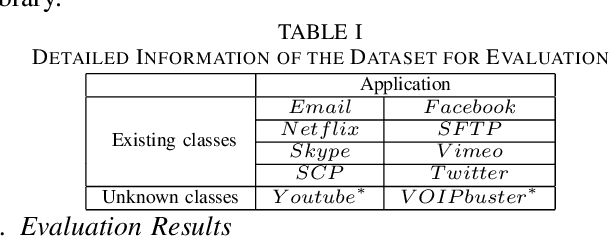
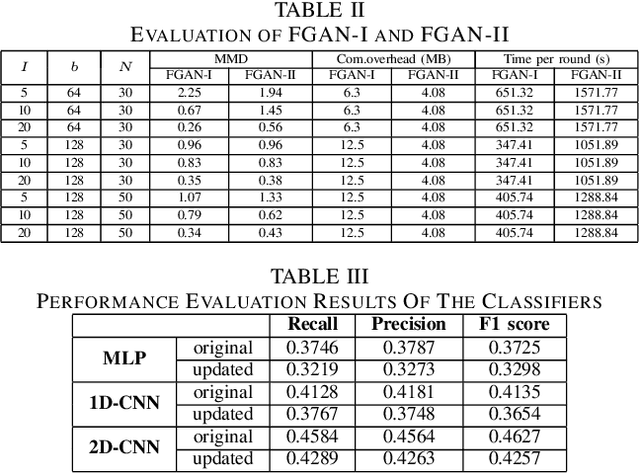
Abstract:With the fast growing demand on new services and applications as well as the increasing awareness of data protection, traditional centralized traffic classification approaches are facing unprecedented challenges. This paper introduces a novel framework, Federated Generative Adversarial Networks and Automatic Classification (FGAN-AC), which integrates decentralized data synthesizing with traffic classification. FGAN-AC is able to synthesize and classify multiple types of service data traffic from decentralized local datasets without requiring a large volume of manually labeled dataset or causing any data leakage. Two types of data synthesizing approaches have been proposed and compared: computation-efficient FGAN (FGAN-\uppercase\expandafter{\romannumeral1}) and communication-efficient FGAN (FGAN-\uppercase\expandafter{\romannumeral2}). The former only implements a single CNN model for processing each local dataset and the later only requires coordination of intermediate model training parameters. An automatic data classification and model updating framework has been proposed to automatically identify unknown traffic from the synthesized data samples and create new pseudo-labels for model training. Numerical results show that our proposed framework has the ability to synthesize highly mixed service data traffic and can significantly improve the traffic classification performance compared to existing solutions.
Spatio-temporal Modeling for Large-scale Vehicular Networks Using Graph Convolutional Networks
Mar 13, 2021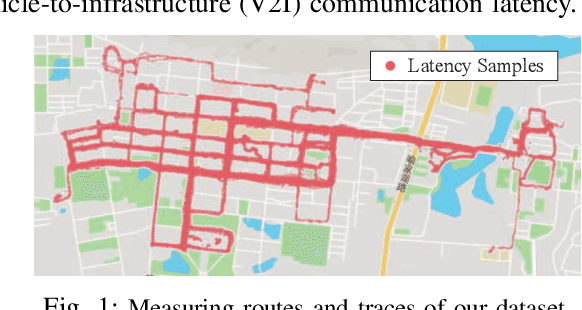
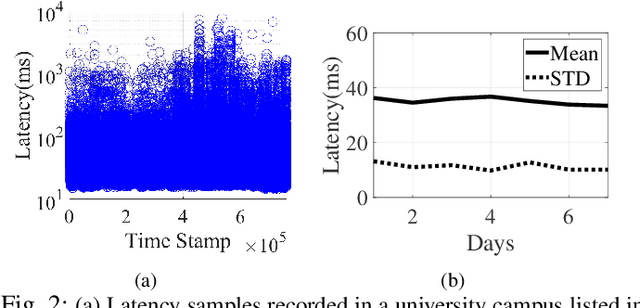

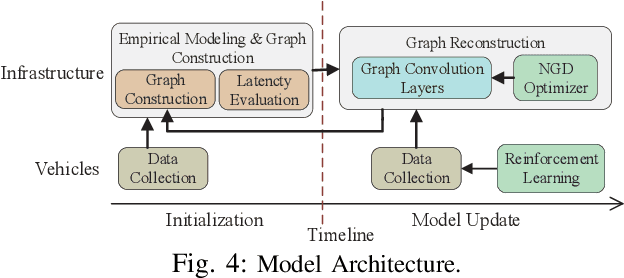
Abstract:The effective deployment of connected vehicular networks is contingent upon maintaining a desired performance across spatial and temporal domains. In this paper, a graph-based framework, called SMART, is proposed to model and keep track of the spatial and temporal statistics of vehicle-to-infrastructure (V2I) communication latency across a large geographical area. SMART first formulates the spatio-temporal performance of a vehicular network as a graph in which each vertex corresponds to a subregion consisting of a set of neighboring location points with similar statistical features of V2I latency and each edge represents the spatio-correlation between latency statistics of two connected vertices. Motivated by the observation that the complete temporal and spatial latency performance of a vehicular network can be reconstructed from a limited number of vertices and edge relations, we develop a graph reconstruction-based approach using a graph convolutional network integrated with a deep Q-networks algorithm in order to capture the spatial and temporal statistic of feature map pf latency performance for a large-scale vehicular network. Extensive simulations have been conducted based on a five-month latency measurement study on a commercial LTE network. Our results show that the proposed method can significantly improve both the accuracy and efficiency for modeling and reconstructing the latency performance of large vehicular networks.
Optimizing Resource-Efficiency for Federated Edge Intelligence in IoT Networks
Nov 25, 2020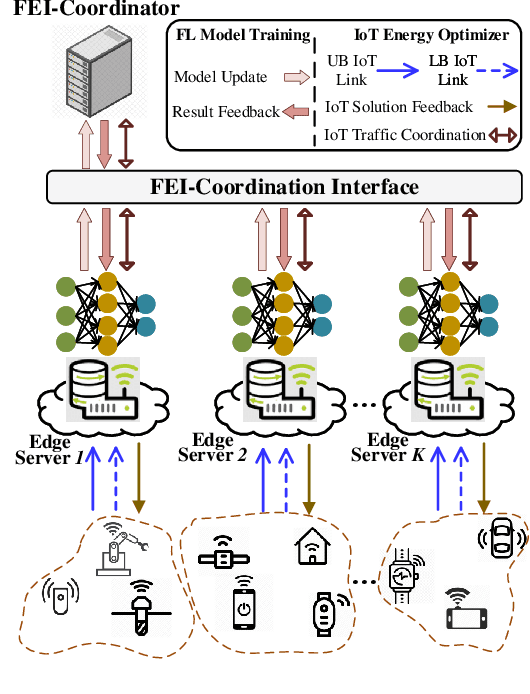
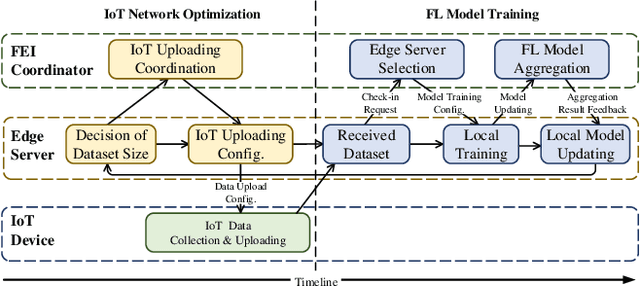
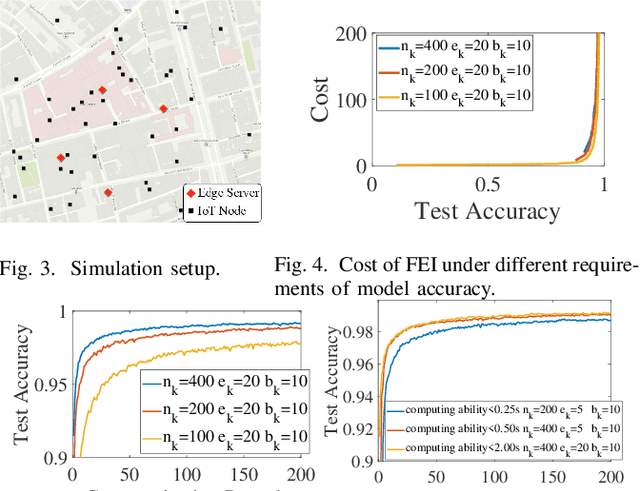

Abstract:This paper studies an edge intelligence-based IoT network in which a set of edge servers learn a shared model using federated learning (FL) based on the datasets uploaded from a multi-technology-supported IoT network. The data uploading performance of IoT network and the computational capacity of edge servers are entangled with each other in influencing the FL model training process. We propose a novel framework, called federated edge intelligence (FEI), that allows edge servers to evaluate the required number of data samples according to the energy cost of the IoT network as well as their local data processing capacity and only request the amount of data that is sufficient for training a satisfactory model. We evaluate the energy cost for data uploading when two widely-used IoT solutions: licensed band IoT (e.g., 5G NB-IoT) and unlicensed band IoT (e.g., Wi-Fi, ZigBee, and 5G NR-U) are available to each IoT device. We prove that the cost minimization problem of the entire IoT network is separable and can be divided into a set of subproblems, each of which can be solved by an individual edge server. We also introduce a mapping function to quantify the computational load of edge servers under different combinations of three key parameters: size of the dataset, local batch size, and number of local training passes. Finally, we adopt an Alternative Direction Method of Multipliers (ADMM)-based approach to jointly optimize energy cost of the IoT network and average computing resource utilization of edge servers. We prove that our proposed algorithm does not cause any data leakage nor disclose any topological information of the IoT network. Simulation results show that our proposed framework significantly improves the resource efficiency of the IoT network and edge servers with only a limited sacrifice on the model convergence performance.
Towards Self-learning Edge Intelligence in 6G
Oct 01, 2020

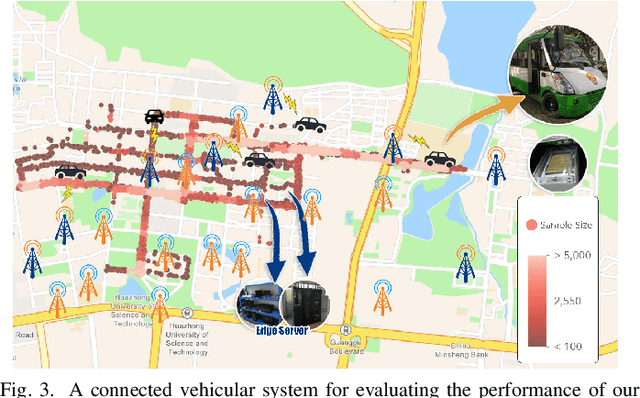
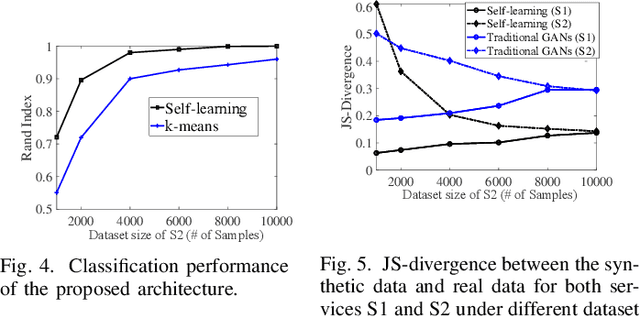
Abstract:Edge intelligence, also called edge-native artificial intelligence (AI), is an emerging technological framework focusing on seamless integration of AI, communication networks, and mobile edge computing. It has been considered to be one of the key missing components in the existing 5G network and is widely recognized to be one of the most sought-after functions for tomorrow's wireless 6G cellular systems. In this article, we identify the key requirements and challenges of edge-native AI in 6G. A self-learning architecture based on self-supervised Generative Adversarial Nets (GANs) is introduced to \blu{demonstrate the potential performance improvement that can be achieved by automatic data learning and synthesizing at the edge of the network}. We evaluate the performance of our proposed self-learning architecture in a university campus shuttle system connected via a 5G network. Our result shows that the proposed architecture has the potential to identify and classify unknown services that emerge in edge computing networks. Future trends and key research problems for self-learning-enabled 6G edge intelligence are also discussed.
A Generative Learning Approach for Spatio-temporal Modeling in Connected Vehicular Network
Mar 16, 2020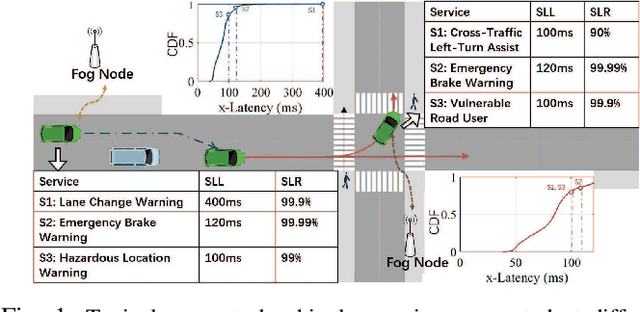

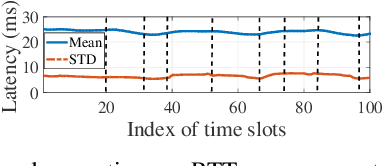

Abstract:Spatio-temporal modeling of wireless access latency is of great importance for connected-vehicular systems. The quality of the molded results rely heavily on the number and quality of samples which can vary significantly due to the sensor deployment density as well as traffic volume and density. This paper proposes LaMI (Latency Model Inpainting), a novel framework to generate a comprehensive spatio-temporal of wireless access latency of a connected vehicles across a wide geographical area. LaMI adopts the idea from image inpainting and synthesizing and can reconstruct the missing latency samples by a two-step procedure. In particular, it first discovers the spatial correlation between samples collected in various regions using a patching-based approach and then feeds the original and highly correlated samples into a Variational Autoencoder (VAE), a deep generative model, to create latency samples with similar probability distribution with the original samples. Finally, LaMI establishes the empirical PDF of latency performance and maps the PDFs into the confidence levels of different vehicular service requirements. Extensive performance evaluation has been conducted using the real traces collected in a commercial LTE network in a university campus. Simulation results show that our proposed model can significantly improve the accuracy of latency modeling especially compared to existing popular solutions such as interpolation and nearest neighbor-based methods.
 Add to Chrome
Add to Chrome Add to Firefox
Add to Firefox Add to Edge
Add to Edge